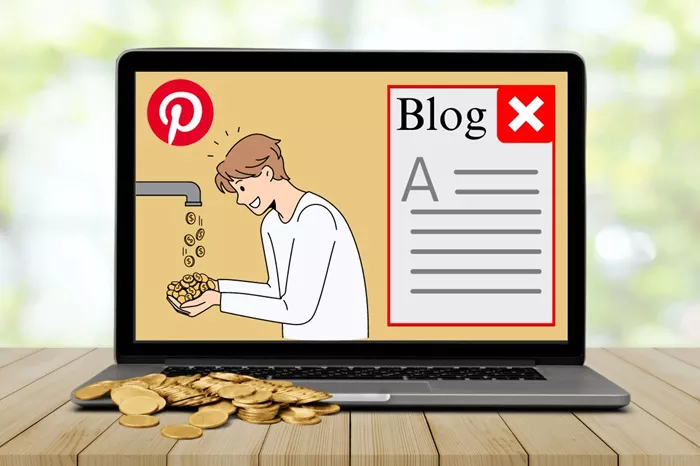Blogging and Pinterest go hand in hand, offering a powerful platform to grow your audience and monetize your content. Pinterest is not just a social media network; it functions as a search engine where users look for ideas, inspiration, and solutions. By effectively utilizing Pinterest, you can drive traffic to your blog and create multiple streams of income. Here’s a comprehensive guide to making money blogging on Pinterest.
Why Use Pinterest For Blogging?
Pinterest has become a favorite platform for bloggers due to its unique combination of features:
Massive User Base: Pinterest has millions of active users searching for ideas and inspiration every day.
Long-Term Content Lifespan: Unlike other platforms, content on Pinterest (pins) can gain traction for months or even years.
Search Engine Capability: Users actively search for specific content, making it easier to target the right audience.
By leveraging Pinterest effectively, you can gain consistent traffic to your blog, which opens up numerous monetization opportunities.
Setting Up Your Pinterest Account for Success
1. Create a Business Account
A Pinterest business account offers features like analytics and advertising that can help you optimize your strategy.
- Navigate to Pinterest’s settings and convert your personal account to a business account.
- Ensure your blog’s URL is connected to your Pinterest account.
2. Optimize Your Profile
Your profile is your online storefront. Make it appealing and informative.
- Use a professional profile picture.
- Write a keyword-rich bio that reflects your niche and blog content.
- Add a link to your blog in the profile description.
Developing a Pinterest Content Strategy
1. Pin Consistently
Consistency is key to building an audience. Aim to pin at least 10-15 times a day.
- Use a mix of original pins (content from your blog) and repins (relevant content from others).
- Schedule your pins using tools like Tailwind to ensure a steady flow of content.
2. Create Eye-Catching Pins
Pinterest is a highly visual platform. Your pins must stand out to attract clicks.
- Use bold, high-quality images.
- Add descriptive text overlays that highlight the value of your blog post.
- Maintain brand consistency with colors and fonts.
3. Leverage Keywords
Pinterest functions as a search engine. Optimize your content by:
- Including keywords in pin titles and descriptions.
- Using hashtags to increase visibility.
- Researching trending keywords using Pinterest’s search bar or tools like Pinterest Trends.
Driving Traffic To Your Blog
1. Focus on High-Value Content
Create blog posts that solve problems or provide inspiration for your audience.
- Use listicles, how-to guides, or in-depth tutorials.
- Incorporate visuals like infographics and videos to make posts engaging.
2. Use Call-To-Actions (CTAs)
Encourage Pinterest users to click through to your blog.
- Add clear CTAs in your pin descriptions like “Click to read more” or “Learn how here.”
- Ensure your blog posts deliver on the promise made in your pins.
Monetization Strategies For Blogging With Pinterest
1. Affiliate Marketing
Promoting affiliate products is one of the easiest ways to earn money.
Write blog posts that naturally incorporate affiliate links, such as product reviews or “best of” lists.
Create pins for these posts and link them back to your blog.
2. Display Advertising
Once you’ve built consistent traffic, apply for ad networks like Google AdSense or Mediavine.
Ads will generate passive income based on impressions and clicks.
3. Sponsored Content
Collaborate with brands to create sponsored posts.
Use Pinterest to showcase these posts and drive traffic to your blog.
Ensure the sponsored content aligns with your audience’s interests.
4. Digital Products
Sell your own digital products, such as e-books, printables, or online courses.
Use pins to highlight the value of your products and direct users to your sales pages.
5. Services
Promote services like coaching, consulting, or freelancing.
Use Pinterest to share testimonials, case studies, or portfolio highlights.
Analyzing and Optimizing Your Pinterest Performance
1. Monitor Analytics
Pinterest provides analytics to track your pins’ performance. Focus on metrics such as:
- Impressions
- Clicks
- Saves
2. Experiment and Improve
Test different pin designs, descriptions, and keywords to see what works best.
- Analyze which types of pins drive the most traffic.
- Replicate successful strategies for new blog posts.
Common Mistakes To Avoid
Inconsistent Pinning: Sporadic pinning leads to reduced visibility.
Ignoring SEO: Without proper keyword usage, your pins will struggle to appear in searches.
Poor Pin Design: Bland or cluttered pins will fail to attract clicks.
Lack of Clear Goals: Define your monetization strategy early to align your efforts with revenue generation.
Building Long-Term Success
Success on Pinterest requires patience and persistence. Focus on building a strong foundation by:
- Regularly updating your blog with fresh content.
- Continuously refining your Pinterest strategy.
- Engaging with your audience through comments and shares.
By treating Pinterest as an integral part of your blogging journey, you can establish a profitable and sustainable online presence.
Conclusion
Pinterest offers endless potential for bloggers looking to grow their audience and monetize their content. From affiliate marketing to selling digital products, the platform provides multiple avenues for income generation. With a well-optimized Pinterest strategy and consistent effort, you can transform your blog into a thriving business.
Start leveraging Pinterest today, and watch your blogging success soar!
Related Topics

